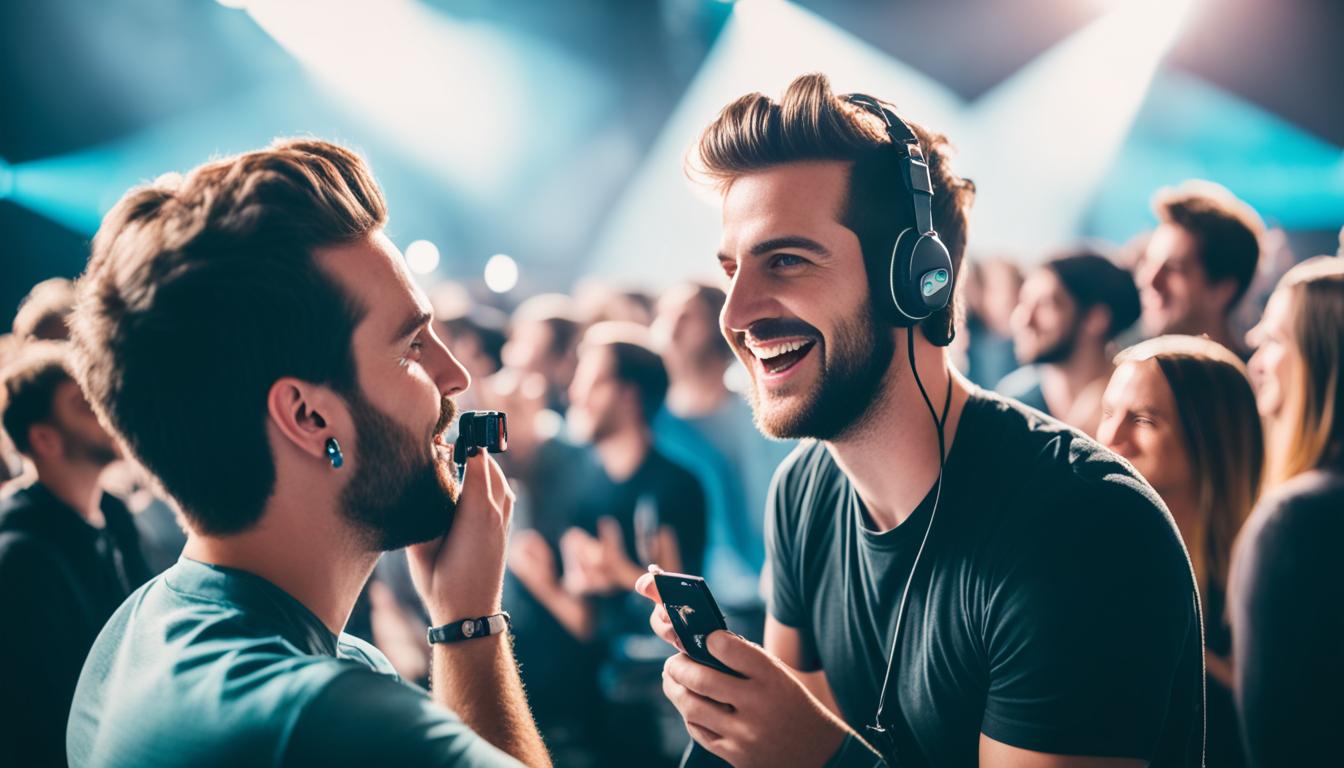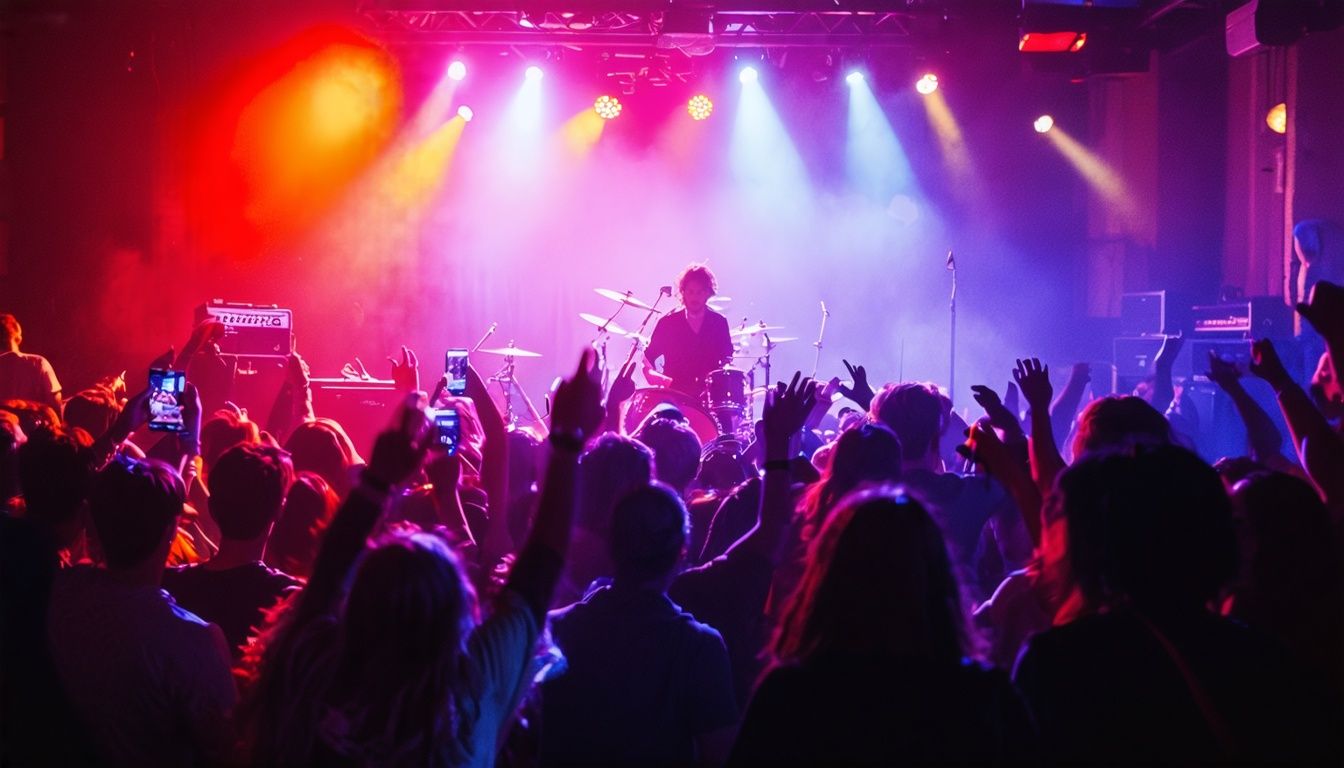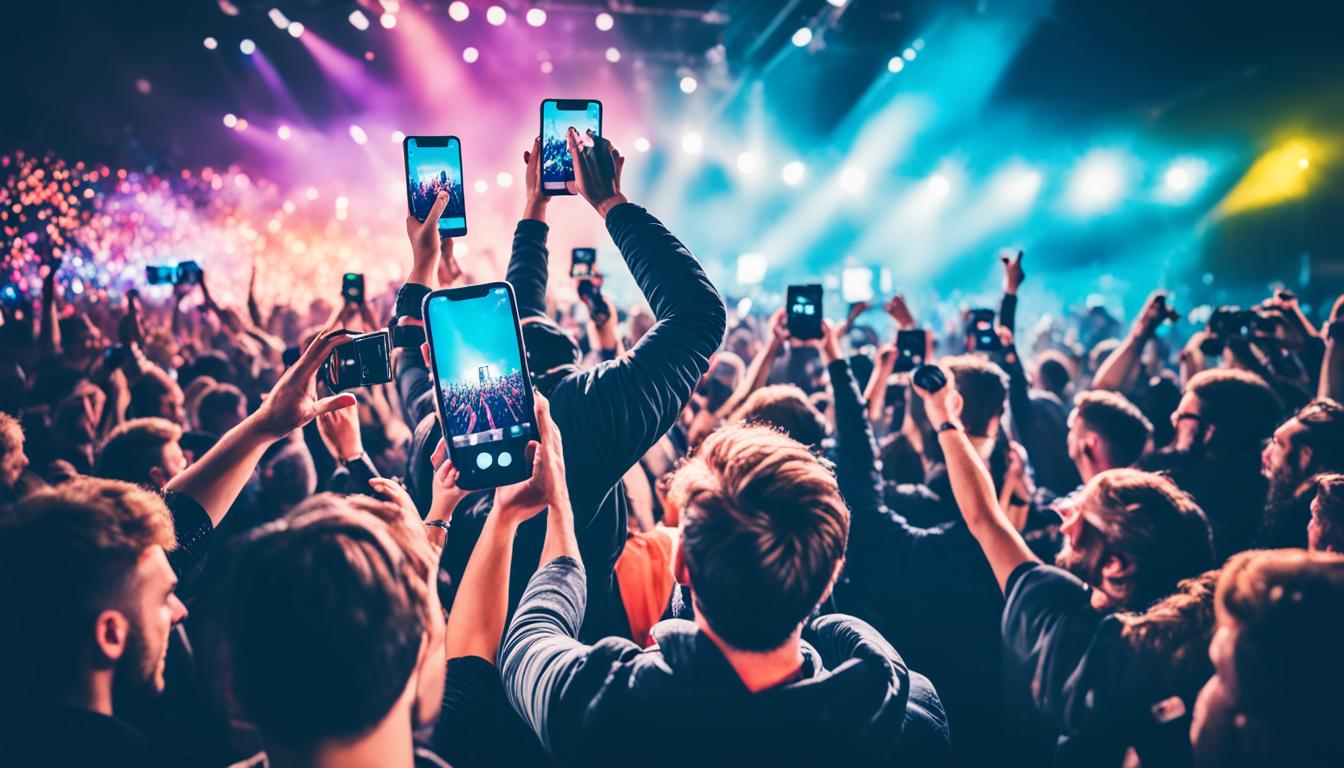We dive into concert photography to turn live music’s energy into beautiful pictures. This art needs a sharp eye, fast reflexes, and knowledge of photography. Our aim is to be respectful in the photo pit. We strive to catch unforgettable moments for all to see, whether online or for personal enjoyment.
The essence of concert photography isn’t just the gear we use. It’s about the community we form, free from bias. We respect each other’s space, share our passion, and tell stories through our images. Together, let’s move from the lively pit to the acclaimed print. In this journey, every photo, frame, and print adds to the story of live music photography.
Key Takeaways
- Embrace live music photography with an eye for capturing raw energy.
- Adopt music photography techniques that respect the dynamics of the photo pit.
- Learn how to shoot concerts with respect for fellow photographers.
- Focus on concert photography editing to enhance the storytelling.
- Understand the importance of sharing your concert photography passively.
Entering the Concert Photography Scene
Entering concert photography is thrilling. It’s more than just holding a camera. You navigate crowds, vibe with the music, and capture stories. Building a standout concert photography portfolio is crucial. It proves your professionalism both in front and behind the camera. Let’s learn to thrive in this exciting area.
Fostering Professional Relationships and Etiquette
Success in concert photography relies on strong relationships. Good etiquette gains respect and opens new opportunities. For better concert photography tips, being seen positively by others is key. It helps us connect with fellow photographers and influential people in the music industry.
Understanding the Importance of Photo Pit Conduct
How you act in the photo pit reflects your professionalism. Moving for the perfect shot, while respecting others, is essential. Small actions like a nod or smile foster a welcoming environment. It’s about our shared love for sharing concert photos online and capturing unforgettable moments.
Handling Gender and Equipment Bias with Grace
Concert photography faces biases, like any creative field. These should not affect how we’re viewed. Overcoming biases gracefully, and pushing for equality enriches our community. Our concert photography portfolio should show our quality work. We set an example for others and promote acceptance.
Being seen as reputable concert photographers is key. This involves refining our skills and valuing friendship over competition. Each photo we take tells a story. They are our legacy, marking our place among music’s visual storytellers.
| Etiquette Aspect | Description | Impact on Professional Relationships |
|---|---|---|
| Positive Interaction | A friendly nod or gesture to fellow photographers. | Enhances camaraderie and opens up networking opportunities. |
| Respectful Space Sharing | Mindful of personal space and shooting angles in the pit. | Lays the foundation for mutual respect and future collaboration. |
| Handling Biases | Addressing discriminatory behaviors with professionalism. | Promotes an egalitarian environment that values merit over prejudice. |
Essential Gear for Every Concert Photographer
For concert photographers, having the right concert photography gear is key. It’s about more than just being there; it’s about having the tools that shine in the concert scene. A professional DSLR and a 24-70mm lens are must-haves for capturing every detail.
A top-notch camera body and the right lenses are crucial. High-quality zoom lenses help keep up with live action. They work well in low light and complex stages. Lens hoods and filters shield your gear, while extra batteries mean you never miss a shot.

Post-show editing is where the real magic happens. The perfect concert photography editing software takes good photos to great. It’s all about honing your concert photography editing skills. This way, you turn raw moments into polished, vivid images that capture the concert’s energy.
Choosing the right gear is your first step to great shots. Remember, your skill and vision are what truly matter. The right gear is like a painter’s best brushes; they help you create your masterpiece with ease and precision.
Mastering the Technical Aspects of Live Music Photography
Exploring live music photography means learning key music photography techniques. It’s crucial for getting those perfect shots. Knowing how to shoot concerts well depends a lot on using manual settings. This is because concerts have fast-changing lights and lots of movement. Manual mode lets you adjust quickly to capture the show’s vibrant moments.
Manual Mode and Exposure Essentials
Auto settings on cameras often fail at concerts due to quick changes in light and motion. This is why manual mode is better. You can control aperture, shutter speed, and ISO yourself. This helps you get bright, energetic photos that automatic mode might miss. With a wide aperture, you capture more light. And a fast shutter speed stops the action clearly. This is what makes music photography techniques work.

Lenses and Focal Lengths for Diverse Venues
Picking the right lens is very important for concert photos. Whether it’s a tiny venue or a huge stadium, your lens matters. Fast lenses with image stabilization are great for low light. They let you use slower shutter speeds without losing image sharpness. Telephoto lenses are good for zooming in from a distance. Wide-angle lenses help you show off the venue size and the audience’s excitement. Each lens lets you tell a part of the concert’s story through your photos.
From Pit to Print: Sharing Your Concert Photography
Immersing ourselves in the excitement of live music lets us capture moments that touch the soul. Sharing these photos turns fleeting scenes into lasting stories. The journey continues as we pick the most emotive images to share.
We don’t just stop at clicking photos. Choosing pictures that capture the concert’s spirit is crucial. Then, we use editing software to make these images even more captivating for our audience.
Sharing concert photos involves understanding copyright laws and respecting artists’ and venues’ rights. It’s our responsibility to protect our work legally. This ensures our photography maintains its professionalism and integrity.
We make sure every photo we share respects the craft and its subjects. Doing this highlights the quality of our concert photography.
When we share a photo, we’re inviting people to see the concert through our eyes. They can feel the emotions, the performance’s intensity, and the audience’s reaction. Every image is a chapter of a larger story, told with our unique view.
Following solid photography tips makes our visuals more impactful. Our passion, skill, and dedication come together from the pit to print. This cements our role in visual and musical storytelling.
FAQ
How can I share my concert photography effectively?
To share your concert photos well, create an online portfolio. Use social media sites, and join music and photo groups. Always tag the artists and use right hashtags to get seen more. Make sure you’re allowed to share the pics. Know about any copyright rules.
What are the essential tips for live music photography?
Key tips are to know your camera well and guess the artist’s next move. Learn about the stage lights, shoot in manual, and be polite in the photo area. Always try to capture the show’s emotion and energy.
How should I navigate professional relationships and etiquette in concert photography?
Build good professional links by networking and showing respect to everyone in the field. When in the photo pit, be nice and considerate. Stand up for a fair community, not caring about someone’s gear or gender.
What is the importance of photo pit conduct?
Good photo pit behavior creates a professional space for photographers to work well. It means giving others space, not ruining their shots, and following silent rules. For example, the rule about only shooting the first three songs.
How do I handle gender and equipment bias in the concert photography community?
Deal with bias by always acting professional and showing what you can do. Speak out if you see unfair treatment, support your fellow photographers, and focus on your work’s quality, not your gear.
What gear should every concert photographer have?
Every concert photographer needs a good camera, a fast lens like a 24-70mm, extra batteries, and memory cards. A monopod can also help keep your shots steady. Different lenses might be needed based on the place and type of shots.
What editing software is recommended for concert photography?
Adobe Lightroom and Photoshop are top choices for editing concert pictures because they’re powerful and versatile. Capture One and DxO PhotoLab are also good options.
Why is manual mode critical in concert photography?
Manual mode is key as it lets you fully control exposure settings. This is vital for quickly adapting to changing lights at concerts.
Which lenses and focal lengths are best for diverse concert venues?
For low light, fast lenses with wide openings are best. A 24-70mm lens is versatile, while a 70-200mm suits big places. Prime lenses like the 50mm or 85mm are great for their quality and wide openings.



